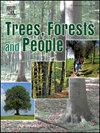Selecting dominant or rare tree species as habitat trees: Consequences for epiphyte diversity in temperate mountain forests
IF 2.7
Q1 FORESTRY
引用次数: 0
Abstract
The retention of habitat trees, defined as large old trees saved from logging, is a key strategy for biodiversity conservation in production forests. Epiphytic bryophytes and lichens, which rely on the diverse microhabitats provided by large old trees, are expected to benefit significantly from this practice. The selection of habitat trees has become mandatory in some governmental biodiversity conservation strategies. While broadleaved trees are known to support epiphytes, the role of forest stand characteristics remains less understood. This study investigates whether selecting habitat trees of a stand's dominant tree species or of rare accessory tree species is most effective to conserve a high species richness of epiphytic bryophytes and lichens using 132 study plots and 657 habitat trees in temperate mountain forest of southwestern Germany, representing beech, spruce, and spruce co-dominant forests. Tree species identity of the habitat tree had different effects on epiphyte diversity for different forest types. In beech forest, epiphyte species richness was increased if the habitat tree was also a beech tree; this relationship was primarily driven by bryophytes. In spruce forests and spruce co-dominant forests, epiphyte species richness was higher if rare accessory tree species were selected as habitat trees. This result may guide foresters during habitat tree selection, which has become an important issue at least in German forest management.
求助全文
约1分钟内获得全文
求助全文
来源期刊

Trees, Forests and People
Economics, Econometrics and Finance-Economics, Econometrics and Finance (miscellaneous)
CiteScore
4.30
自引率
7.40%
发文量
172
审稿时长
56 days
 求助内容:
求助内容: 应助结果提醒方式:
应助结果提醒方式:


